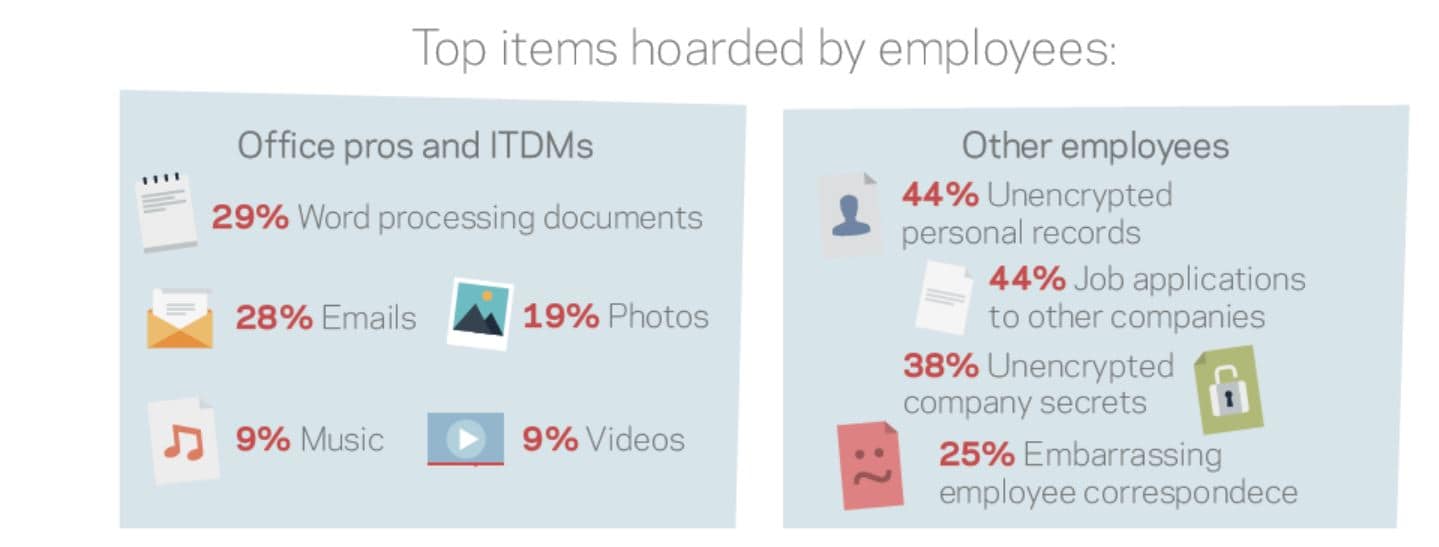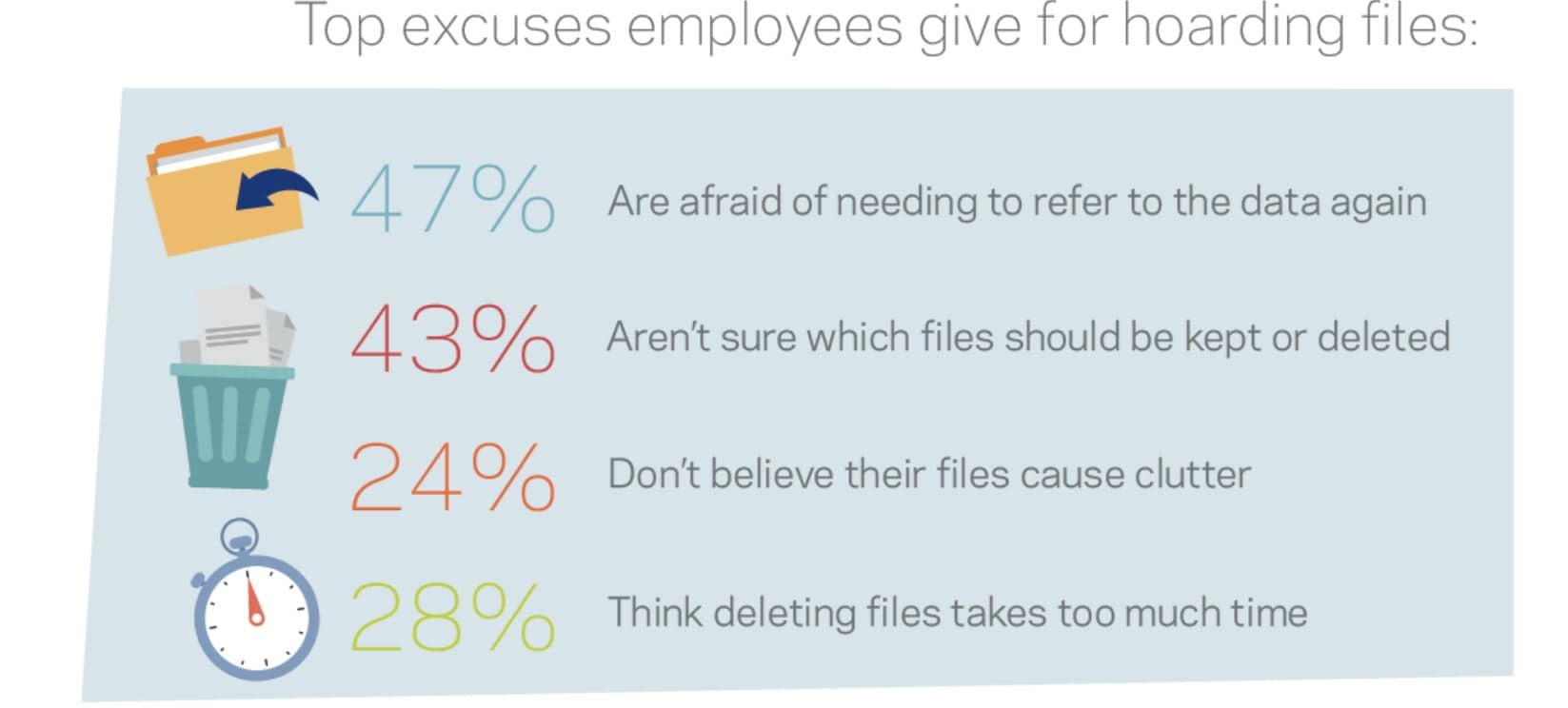The data employees save puts businesses at risk.
Are you a Data Horder?
62% of office professionals and 82% of IT decision makers admit they are data hoarders.
But what does that mean? And why is it something that businesses should be concerned about? Physical hoarders, whose houses are piled high with keepsakes, can quickly become run-down. As hard drives and cloud storage around the world bulge at the seams, businesses risk losing their agility and innovation. Companies such as AirBnB, Uber and Booking.com are examples of companies that have lots of data, but turn it into a positive, using their digital currency in the right ways.
41% of data hasn’t been touched in three years¹. Yet people don’t want to delete their files, but neither are they forced to. Cheap, high capacity storage devices, extend the myth of ‘free’ storage. While that exists, the incentives to delete information do not. However, this rising level of data² is a problem for businesses because digital hoarding slows down company workflows, it clogs server space. It presents tangible risks to any organisation affected by it.
83% of IT decision-makers believe that their company is a data hoarder.
More than 77% are more concerned about its impact now than one year ago
It’s not just the costs of storing hoarded data that should alarm companies. Within the dark data lies information that may be needed for compliance, is business-critical or breaches copyrights or data privacy rights. If you can’t find it or don’t know it’s there, you’re in a dangerous position. Some of that data is even actively harmful. Unencrypted files increase the risk of a data breach, whereupon most companies can’t respond quickly because their high data volume hampers them.
Who is responsible for this hoarding behaviour?
Almost two-thirds (62%) of office professionals admit to being data hoarders. Some of the items stored are, of course, essential files for both the individual and the company. But many are not. More than 90% of this employees⁴ admit to adding personal files to company storage. These files include job applications to other companies and embarrassing correspondence with other employees. Things that probably shouldn’t be stored there in the first place. Nevertheless, they’re very attached to that data. Half of all data hoarders would rather get rid of all their clothes⁵ or work weekends⁶ for three months than relinquish their digital files. This behaviour perpetuates a situation that hoarders can’t get out of. Many employees try and fail to purge their data. Others hope to but never even start. They hoard but are they the real culprits?
Culture change
The real problem is that companies lack the correct culture and processes to tackle the problem. IT decision-makers to are guilty of hoarding, but it’s the lack of clear strategy that makes them the root of the problem. Data is expanding, and companies have often decided to keep it because it might be valuable. But their approach to allow this has been a hardware-led one. By throwing ‘free’ storage at the problem (compounding the myth), they unwittingly encourage their employees to hoard. It is a cultural and behavioural problem, not a technological one.
It doesn’t help, of course, that hoarding isn’t seen as an issue by 82% of non-IT executives. Without the support of the C-level, most IT decision makers⁷ don’t have the time and resources to deal with the problem.
 What’s the way forward to solve the hoarding problem?
What’s the way forward to solve the hoarding problem?
The pathway to minimise hoarding is not always a simple one. Data hoarding behavior is often enabled by company culture, so there’s a social element to the solution. Cultural change and education needs to show employees a new way. Data is highly important to businesses – it’s their lifeblood in many cases. So there also needs to be a technical element to how they manage it that enables important data to be stored and used, while peripheral data is jettisoned. Each organisation has an opportunity to transform its IT department and identify new business opportunities by better understanding which data is business critical. They can also start to delete the 31% of data that is already known to add no value back into the business.
Here’s how to start:
- Culture and Behavior Changes:
Constantly educate employees that the company’s IT systems are not their property. Inform them about the costs that they create with their risky behavior and explain the impact on the business. This helps employees appreciate the value of information, paving the way for better data management.
- Define Collaboration and Responsibility:
Compliance teams, marketing and IT have a stake in corporate data, as well as different access, archiving and management requirements. Establish a collaborative culture between these departments. A Chief Data Officer or Chief Digital Officer could help translate the business needs into clearly defined data management and analytics processes, and drive the cultural shift.
- Visibility and Classification:
To make decisions around data, you need to understand what is stored. More difficult when the company’s infrastructure is fragmented. Turn the lights on. See what is stored, who is accessing it and how often. Then classify data based on a bespoke data retention policy. Only 16% of organizations do all of this today.
- Identify and Remediate Risks:
If you don’t know what you’re storing, you can’t be compliant. Employees hoarding personal files could violate copyrights, not to mention data privacy rights that might be affected after they leave the company. Analysing and classifying dark data enables a workable information governance strategy. Identifying these risks at an early stage allows them to be remediated.
- Start to Delete:
Focus first on data that is obviously redundant, trivial or obsolete. Deletion of these files should be guided by a policy and should happen at least once a quarter. A deletion in September, for instance, could help clear out employees’ summer holiday photos and videos. Companies that build “a value of information” driven culture will excel in an information driven economy. The sharing, ownership and lifecycle management of data needs to suit evolving business needs. When it does, this agility and transparency will enable businesses to drive major efficiencies and get more value from the information it chooses to keep.
Methodology
We are revealing exclusive findings from an independent research report into organizational data management. Covering over 10,000 respondents across 13 countries, this study, conducted for Veritas by research firm Wakefield Research, explored the data habits of both IT decision makers and office professionals and asked how their behavior is affecting their company’s data management posture. The Data Horder Report is based on a survey of over 10,000 IT decision makers and office professionals throughout the globe that questioned their data storage habits. The report reveals insights into digital behaviors that are critical to data management, data risk and behaviours towards digital possessions vs tangible ones.
Find out more about Information Governance
About Veritas
Veritas Technologies enables organisations to harness their information, bolstering business success in even the most complex environments. They serve organisations of all sizes, including 86 percent of global Fortune 500 companies. In fact, for over a decade, Veritas has been recognised as a leader in the Gartner Magic Quadrant for both Enterprise Backup Software and Integrated Appliances¹ and Enterprise Information Archiving.² Together with their experienced partner community, they help customers improve their data availability and unlock insights to make them more competitive. With over 7,800 employees in 58 countries worldwide, Veritas is a $2.5 billion company that partners with the largest technology leaders, including Amazon, Cisco, Fujitsu, Google, Hitachi, HP, IBM, Microsoft, NetApp, OpenStack, Symantec, and many more. From traditional data centres to private, public, and hybrid clouds, Veritas, together with its partner community, helps enterprises—regardless of their environment—protect, identify, and manage data using intelligent information management solutions. With Veritas, enterprises have the insight and availability they need to understand what information they have, know how to keep it protected and realise what they should delete.
References:
1 From the Veritas Data Genomics Index: http://datagenomicsproject.org/DGI-Report-Feb-2016.pdf
2 Data growth at the file level over the past seven years is 39% (Data Genomics Index)
3 Stats from Databerg Report 2015: http://info.veritas.com/databerg_report
4 93% of digital hoarding office professionals
5 50% of digital hoarding office professionals, and 46% of digital hoarding IT decision makers
6 49% of digital hoarding office professionals, and 48% of digital hoarding IT decision makers
